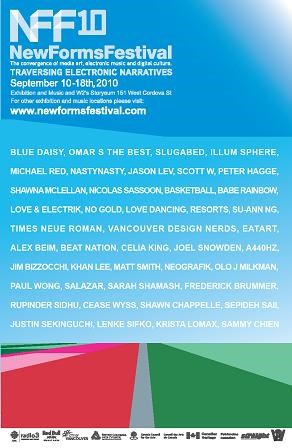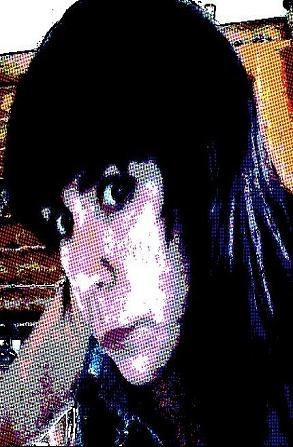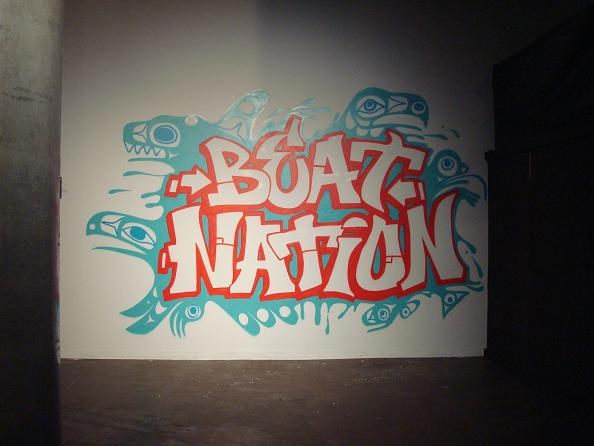The 10th annual New Forms Festival continues tonight with Beat Nation, 8pm- Midnight at the W2 Storyeum in Gastown. Along with pushing the next for electronic music and the arts, tonight the festival and curator Tania Willard showcase a closer look into the movement of indigenous hip hop within traditional & new media.
Tania, from the Secwepemc (Shuswap) Nation, started breaking ground with Red Wire Magazine, one of the first independent Aboriginal youth run arts and media organizations. Beat Nation was originally a website and online gallery from director Glenn Alteen, it has expanded into a full fledged showcase for the artists tonight (with Sista Hailstorm, The Starmakerz – Manik1derful and Magic Touch, Skeena Reece - also co-curator of the Beat Nation exhibition, Ostwelve, Christie Charles) as well as taking part in the festival exhibition which runs from Sep. 18 and is FREE daily from noon-7pm. Tania talks about Beat Nation, how it fit into the vibe of New Forms and how hip hop fits into the aboriginal world below.
Interview with New Forms Festival co-found Malcolm Levy on a decade of the next
Q: Can you tell me how the concept for Beat Nation as a New Forms Festival event came to be? NFF is probably largely thought of as about the "next shit" or futuristic vibe. How do you think Beat Nation fits into this?
A: The concept originally for Beat Nation came from our director Glenn Alteen who had seen a lot of hip hop culture reflected in the Aboriginal community but with this indigenous twist, he asked myself and Skeena Reece both with backgrounds in Aboriginal youth arts to curate the online gallery. The project has grown from there, the association with New Forms Festival came about with festival director Malcolm Levy who was interested in the project as it related to the electronic narratives theme for New Forms. In many ways it is the narrative threads, the storytelling part of hip hop that has really captured Aboriginal communities, an extension of traditional oral culture and storytelling practice.....CONTINUED.
There are a number of artists within Beat Nation working in and around New Media as well, and Nicholas Galanin's video piece that is the New Forms exhibition I think really showcases Aboriginal artists working in new mediums and with hip hop influences but who are really using these practices as new ways of understanding, and sharing indigenous culture(s) and ourselves.
Q:How did the selection process go for getting the MCs and artists for Beat Nation? Can you tell me more about some of the artists?
A: A lot of the artists and MC's were an extension of communities Skeena and I had been involved with, like Redwire Magazine who years ago released an Aboriginal hip hop CD and NYAC (Native Youth Artists Collective) that Skeena helped to found who also formed a bit of a sounds recording studio at their previous location and who were working with a lot of up and coming hip hop artists.
Then there are the originals of the Native hip hop movement here in Vancouver who really came out of the Aboriginal rights movement and were vocal against the BC Treaty Process at the time, the Native Youth Movement really embraced conscious hip hop at the time as a way to get across not only political messages but cultural pride and protocols.
Early shows of Native hip hop were put on by Shawn Desjarlais and Tribal Wisdom and included people like Kinnie Starr, Manik, Os12, and more. So really it was pulling from communities we were associated with and then looking outwards from there, I mean the Native hip hop scene in Canada has established connections and touring trajectories and all that and you don't have to look far to reach musicians who are then networked with MC's and artists because all those elements come together in creating culture naturally especially when you are dealing with smaller communities.
Q: Not that hip hop has to be always political and "conscious" but what extra weight do you think this event brings to the table in these respects?
A: Well in many ways I think all Aboriginal content is inherently political, the fact that we still exist in the midst of policies on the part of the church and the Canadian government is a pretty fierce starting point. And then to bring this sense of exploring and embracing culture that is rich with both a history of injustice but also spirit and strength I think adds a new level in which to understand new media and electronic culture, because we are a part of that.
We are traditional and we have roots and we also are MC's and artists and web designers who are grounded within our aboriginal identity's and sharing and creating with that background with that platform of exploration I think brings a level of richness and grounding to the work, we are not struggling for authenticity we can just represent our realities in all their brutal glory.
Q: Did you have one goal or hope that stands out with Beat Nation over all? Or do you have many?
A: I used to work with Redwire Magazine and am still a big supporter and my experience with Redwire really shaped my understanding of the power of self expression and of sharing our stories and our struggles, Beat Nation is a continuation of this: A journey in supporting, nurturing and developing Aboriginal spaces and places where our voices and our realities are heard but also understood and where the dialogue and the relationships between Native and non Native communities are deepened, because face it there is still so much work to do, most of this country still exists within a context of illusion and racial dominance in the sense of Aboriginal landclaims and the realities on and off reserve with our populations and amongst all that we create and we celebrate because we continue to survive and thrive, four our ancestors, for our grandchildren and for our spirits..All My Relations.
Tania Willard Profile:
Hailing from the Secwepemc (Shuswap) Nation in the Interior of B.C., Tania Willard is a writer, editor, designer, curator and visual artist committed to celebrating Aboriginal expression. An honours graduate from the University of Victoria (1998), Willard utilizes narrative in her various endeavours—in the arts, news media and advocacy—sharing stories, histories and experiences. Her activities, from early work with Redwire Magazine, a national Native youth publication, to more recent curatorial and critical endeavours, demonstrate Willard’s passion for the arts. She states, “I believe we all have a story to share; the stories of this land, our cultures and our experiences enrich our lives.”
Tania Willard Biography:
Tania Willard, Secwepemc Nation, has been working with Aboriginal youth, community, story and the arts for over 10 years. An honours graduate from the University of Victoria, her groundbreaking work with Redwire Magazine, a national Aboriginal youth magazine, led the organization to be one of the first independent Aboriginal youth run arts and media organizations. Tania has since transferred her skills and passion to her work as an artist and graphic designer, again the focus of her work in this field is the Aboriginal community, the arts, health and social justice. Tania has worked as an artist in residence with Stanley Park Ecology Society, gallery gachet in Vancouver’s Downtown East Side, a writer in residence with Native Women in the Arts and the Banff Centre's fiction residency. Collection's of Willard's work include the Department of Foreign Affairs and International Trade and Kamloops Art Gallery. Her recent work with Stanley Park's environmental art project focusses on Aboriginal presence and absence in Stanley Park through the philosophy of the Cedar Tree as the tree of life. Recently awarded a curatorial residency with grunt gallery, Tania has worked with grunt gallery to coordinate their community arts conference and publication, Live in Public: The Art of Engagment and recent online gallery projects including Beat Nation: Hip Hop as Indigenous Culture, Dana Claxton’s retrospective and the First Visions site.





